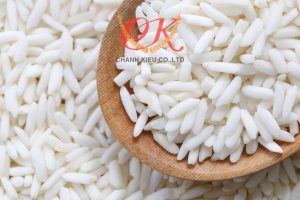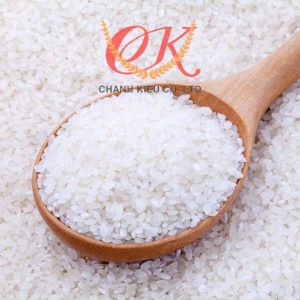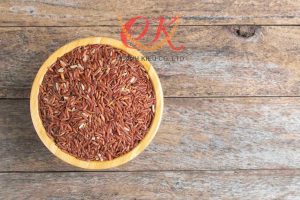Tin Tức Lúa Gạo
Gạo lứt khác gì gạo thông thường
Gạo trắng và gạo lứt
Gạo trắng và gạo lứt là hai loại gạo có sự khác biệt quan trọng về quá trình xay xát và giá trị dinh dưỡng. Gạo trắng được thu được sau khi đã loại bỏ vỏ trấu, phần cám và mầm. Mặc dù quá trình này giúp tăng thời hạn sử dụng và làm cho hạt gạo trắng sáng và thu hút hơn, nhưng lại làm mất đi nhiều chất dinh dưỡng quan trọng như chất xơ, các khoáng chất và vitamin.
Ngược lại, gạo lứt là loại ngũ cốc nguyên hạt, chỉ loại bỏ phần vỏ bên ngoài và vẫn giữ nguyên lớp cám và mầm. Nhờ điều này, gạo lứt chứa nhiều chất dinh dưỡng hơn gạo trắng, bao gồm chất xơ, magie, sắt, thiamine và kẽm. Mức chỉ số đường huyết (GI) của gạo lứt cũng thấp hơn so với gạo trắng. Các chuyên gia dinh dưỡng cho biết việc sử dụng gạo lứt có thể giúp giảm nồng độ cholesterol trong máu và giảm nguy cơ mắc bệnh tim, đột quỵ và tiểu đường loại 2.
Sự khác biệt về dinh dưỡng
Chất xơ
Chất xơ có trong gạo lứt thường nhiều hơn từ 1-3g so với gạo trắng. Thực tế cho thấy, chất xơ đóng vai trò quan trọng đối với hệ tiêu hóa, giúp giảm các tình trạng táo bón và cung cấp nhiều lợi ích cho sức khỏe tổng thể, bao gồm:
- Hỗ trợ giảm cân: Chất xơ giúp làm no nhanh hơn, hạn chế cơn thèm ăn, hỗ trợ hiệu quả cho việc giảm cân.
- Kiểm soát đường huyết: Chất xơ giúp kiểm soát lượng đường huyết có trong máu, từ đó ngăn ngừa nguy cơ mắc bệnh tiểu đường.
- Giảm mức cholesterol trong máu: Chất xơ hỗ trợ giảm mức cholesterol xấu trong máu, giúp bảo vệ sức khỏe tim mạch.
- Bảo vệ tim mạch: Chất xơ cản trở các tác nhân gây bệnh tim mạch, giúp bảo vệ sức khỏe của hệ tim mạch.
- Hỗ trợ hệ tiêu hóa: Chất xơ là nguồn thức ăn chính để nuôi dưỡng các lợi khuẩn có ích trong đường ruột, giúp hỗ trợ hệ tiêu hóa hoạt động tốt.
Theo khuyến nghị dinh dưỡng, lượng chất xơ khuyến nghị dành cho nam giới dưới 50 tuổi là 38g/ngày, và nam giới từ 51 tuổi trở lên là 30g/ngày. Đối với nữ giới, lượng chất xơ khuyến nghị là 25g/ngày dành cho người dưới 50 tuổi và 21g/ngày dành cho người trên 51 tuổi. Điều này thể hiện tầm quan trọng của chất xơ trong việc duy trì sức khỏe và cân bằng dinh dưỡng hàng ngày.
Selen
So với gạo trắng, lượng selenium có trong gạo lứt chiếm tỷ lệ lớn hơn. Đây là một chất có vai trò không thể thiếu trong việc sản xuất các hormone tuyến giáp, giúp cải thiện sức khỏe hệ thống miễn dịch và chống oxy hóa. Ngoài ra, sự kết hợp giữa selen và vitamin E có công dụng cực lớn, giúp bảo vệ các tế bào của cơ thể khỏi ung thư.
Mangan
Trong danh sách các chất dinh dưỡng trọng yếu của cơ thể, chúng ta không thể không kể đến mangan – một loại khoáng chất thiết yếu, tham gia vào quá trình sản xuất năng lượng và có khả năng chống oxy hóa tuyệt vời. Gạo lứt chính là một nguồn cung cấp dồi dào lượng khoáng chất này, trong khi gạo trắng lại thiếu hụt mangan.
Magie
Gạo lứt có chứa nhiều magie hơn so với gạo trắng. Một khẩu phần trung bình của gạo lứt nấu chín (khoảng 1⁄2 cốc) có thể cung cấp khoảng 11% lượng magie khuyến nghị hàng ngày cho cơ thể.
Magie đóng vai trò quan trọng trong một số chức năng cơ bản của cơ thể, bao gồm đông máu, sản xuất tế bào, hoạt động co cơ và phát triển xương.
Lượng magie khuyến cáo hàng ngày thay đổi tùy theo độ tuổi và giới tính. Đối với phụ nữ đang mang thai và cho con bú, nhu cầu magie cao hơn. Trung bình, người trưởng thành cần khoảng 270-400 mg magie mỗi ngày.
Folate
Gạo trắng là một nguồn cung cấp chất folate tuyệt vời cho cơ thể. Trung bình, một chén gạo trắng chứa từ 195-222 mcg (microgam) folate, tương đương với một nửa nhu cầu khuyến nghị hàng ngày.
Folate đóng vai trò quan trọng trong việc tạo ra DNA và một số vật liệu di truyền khác. Nó cũng tham gia vào quá trình phân chia tế bào của cơ thể. Đây là một chất dinh dưỡng đặc biệt cần thiết đối với phụ nữ trong giai đoạn thai kỳ hoặc có kế hoạch mang thai.
Lượng folate khuyến nghị cho người lớn là khoảng 400 mcg, phụ nữ mang thai là 600 mcg và phụ nữ đang cho con bú là 500 mcg.
Gạo lứt và gạo trắng, nên dùng loại nào?
Mặc dù gạo lứt có nhiều chất dinh dưỡng hơn so với gạo trắng, không thể phủ nhận những lợi ích mà gạo trắng mang lại cho sức khỏe, đặc biệt đối với một số nhóm đối tượng như sau:
- Người bị bệnh thận: Gạo trắng là lựa chọn phù hợp hơn vì ít chất xơ hơn gạo lứt, giúp giảm tải cho hệ tiêu hóa và thận.
- Phụ nữ mang thai và cho con bú: Gạo trắng cung cấp lượng lớn khoáng chất folate, giúp giảm nguy cơ các vấn đề dị tật ở thai nhi và hỗ trợ sự phát triển khỏe mạnh.
- Người có vấn đề về đường ruột: Gạo trắng ít chất xơ hơn, phù hợp cho những người bị tiêu chảy, viêm túi thừa hoặc sau phẫu thuật yêu cầu ít chất xơ.
- Người thực hiện chế độ ăn kiêng giảm cân hoặc tập thể hình: Gạo lứt là lựa chọn phù hợp để hỗ trợ giảm cân và cung cấp năng lượng cho tập luyện.
Do đó, tùy vào mục đích sử dụng, bạn có thể lựa chọn gạo lứt hoặc gạo trắng cho chế độ dinh dưỡng hàng ngày. Tuy nhiên, một giải pháp đơn giản và hiệu quả là kết hợp cả hai loại gạo để cung cấp đầy đủ các dưỡng chất có trong cả gạo lứt và gạo trắng cho cơ thể.
Có nhu cầu mua gạo lứt và gạo trắng? Hãy liên hệ Gạo Chánh Kiều
Nếu bạn đang có nhu cầu mua gạo ngon, uy tín và chất lượng, hãy liên hệ với Gạo Chánh Kiều – đơn vị cung cấp gạo nguyên chất và hữu cơ uy tín, được sản xuất bằng phương pháp truyền thống và hữu cơ, đảm bảo an toàn vệ sinh thực phẩm và đáp ứng các tiêu chuẩn chất lượng và an toàn khắt khe.
White rice and Brown rice
White rice and brown rice are two types of rice that have significant differences in the milling process and nutritional value. White rice is obtained after removing the bran, germ, and husk. Although this process extends its shelf life and makes the rice appear bright and attractive, it also strips away many essential nutrients such as fiber, minerals, and vitamins.
On the contrary, brown rice is a whole grain that only removes the outer husk while retaining the bran and germ. This allows brown rice to contain more nutrients than white rice, including fiber, magnesium, iron, thiamine, and zinc. The glycemic index (GI) of brown rice is also lower than that of white rice. Nutritionists suggest that consuming brown rice can help lower cholesterol levels and reduce the risk of developing heart disease, stroke, and type 2 diabetes.
The nutritional differences
Fiber
Fiber content in brown rice is generally higher by 1-3g compared to white rice. In fact, fiber plays a crucial role in the digestive system, helping to reduce constipation and providing numerous overall health benefits, including:
- Weight management: Fiber helps create a feeling of fullness, curbing cravings and supporting effective weight loss.
- Blood sugar control: Fiber aids in regulating blood glucose levels, preventing the risk of developing diabetes.
- Reducing cholesterol levels: Fiber assists in lowering LDL cholesterol levels, promoting cardiovascular health.
- Cardiovascular protection: Fiber hinders factors that can cause heart diseases, safeguarding the cardiovascular system.
- Digestive system support: Fiber is a primary food source for nourishing beneficial gut bacteria, promoting a healthy digestive system.
According to nutritional recommendations, the recommended fiber intake for adult men under 50 years old is 38g/day, and for men over 51 years old, it is 30g/day. For adult women, the recommended fiber intake is 25g/day for those under 50 years old and 21g/day for those over 51 years old. This highlights the significance of fiber in maintaining daily health and nutrition balance.
Selen
Compared to white rice, brown rice contains a higher proportion of selenium. This is an essential element in the production of thyroid hormones, improving the immune system, and providing antioxidant benefits. Additionally, the combination of selenium and vitamin E has significant effects in protecting the body’s cells from cancer.
Mangan
In the list of vital nutrients for the body, we cannot overlook manganese – an essential mineral involved in energy production and possessing excellent antioxidant properties. Brown rice is a rich source of this mineral, while white rice is deficient in manganese.
Magie
Brown rice contains more magnesium than white rice. A cooked average serving of brown rice (about 1/2 cup) can provide about 11% of the recommended daily intake of magnesium for the body.
Magnesium plays a crucial role in several fundamental functions of the body, including blood clotting, cell production, muscle contraction, and bone development.
The recommended daily intake of magnesium varies depending on age and gender. Pregnant and breastfeeding women have higher magnesium needs. On average, adults require about 270-400 mg of magnesium per day.
Folate
White rice is an excellent source of folate for the body. On average, a cup of white rice contains about 195-222 mcg (micrograms) of folate, equivalent to half of the recommended daily intake.
Folate plays an essential role in DNA synthesis and other genetic materials. It also participates in the cell division process in the body. This nutrient is particularly crucial for women during pregnancy or planning to become pregnant.
The recommended intake of folate for adults is around 400 mcg, while pregnant women require 600 mcg, and breastfeeding women need 500 mcg.
White rice and brown rice, which one to choose?
Although brown rice has more nutrients compared to white rice, we cannot deny the health benefits that white rice provides, especially for certain groups:
- Individuals with kidney issues: White rice is a more suitable choice as it contains less fiber than brown rice, which reduces the burden on the digestive system and kidneys.
- Pregnant and breastfeeding women: White rice provides a significant amount of folate, helping to reduce the risk of fetal defects and support healthy development.
- People with gastrointestinal problems: White rice, being lower in fiber, is suitable for individuals with diarrhea, appendicitis, or post-surgery requiring a low-fiber diet.
- Individuals on weight loss or fitness diets: Brown rice is a suitable choice to support weight loss and provide energy for workouts.
Therefore, depending on the purpose, you can choose either brown rice or white rice for your daily diet. However, a simple and effective solution is to combine both types of rice to provide the body with a complete range of nutrients from both brown and white rice.
Looking to brown rice or white rice? Contact Gạo Chánh Kiều!
If you are interested in purchasing delicious, reputable, and high-quality rice, do not hesitate to get in touch with Gạo Chánh Kiều – a reliable supplier of pure and organic rice, produced using traditional and organic methods, ensuring food safety, and meeting strict quality and safety standards.
🔥 Bảng Giá Gạo Mới Nhất Tại Đây.






